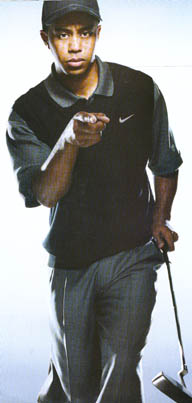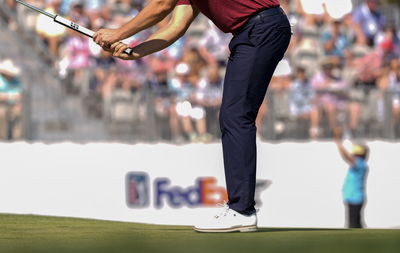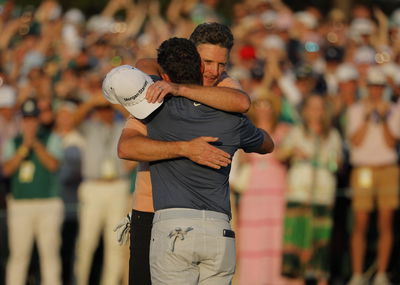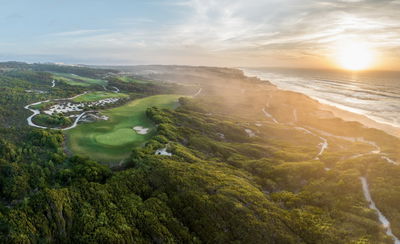
So you wanna play golf, pal?.
|
Golf is a four letter word. It can be exasperating but equally thrilling and invigorating when you strike a ball from the sweet spot on the clubface or hole a long putt across the green.
It can drive you mad, some say it can be better than sex. It can get you into trouble and deliver you from all the cares in the world.
In short it will quickly get you hooked so think carefully before you read our novices guide to starting in golf.
Where can I start playing?
The first thing to know if you are considering starting to play this game for which we all have a passion is where can you play.
Our advice is to start by seeing if your body can adapt to swinging a golf club by visiting a driving range.
These are usually located on the edge of town and have a series of bays or stalls where golfers can stand side by side – in their own space and bash balls into an open area up to 300 yards in length.
You can find them under ‘golf clubs and driving ranges’ in your local yellow pages.
How much will it cost?
At driving ranges you pay by the ball! The more balls you buy in a bucket – usually 50 or 100 – the more you pay. Fifty balls will cost £2-£3 or you can have £100 for less than a fiver.
If you don’t own a golf club or know anyone that will lend you one - a 7-iron is an ideal starter club – hire one from the pro shop at the range for a couple of quid a session. They might even loan you one for free.
You will play off synthetic grass or mats with rubber tees. At first you will want to simply make contact – by imitating the players you’ve seen on TV.
It’s not easy to co-ordinate hands, arms and legs, but you’ll quickly get the hang of it if you don’t try to hit the ball too hard.
Where can I buy equipment?
Our advice is, until you get the hang of the game, don’t go investing in a full set of expensive clubs – neither should you scour the small ads in the local paper for a bargain, unless you can take an experienced golfer with you to help make the purchase.
Go along to your driving range or the local PGA-accredited professional at a golf course – be honest and tell him you’re starting in the game and want to be fixed up with half a set of second hand clubs, a carry bag and a putter. For about £100 he will probably throw in a pair of golf shoes with soft spikes, too.
For the first few months you will be able to manage with a 3-wood, 5-, 7-, 9-iron, sand wedge and a putter.
What about lessons?
It’s best to start with group lessons. This is where five or six of you are taught under the expert eye of a professional teacher.
It will be on the practice range, but in six 30-minute lessons – costing about £25-£30 - you will learn the fundamentals and then be able to practice in your own time.
After a while you will probably want to develop your own game with a series of one to one lessons with the pro – costing about £15 for 30 minutes. But don’t look for instant results. You will have to practice what he preaches with dedication.
Group lessons are also a good way to meet other golfers who are also learning. When you eventually make it to the golf course you don’t really want to play on your own. At least two of you will learn much quicker and you’ll enjoy it more, too.
When do I venture out on the course?
We feel it’s best to start on a pitch and putt course or a nine hole par-3. Golf is about scoring. How many shots you take, not how far you hit it.
For about £5 a round you can have great fun learning how to use the lofted clubs in your bag and developing a repeating putting action. It will also teach you how to roll three shots into two from the edge of the green.
What about the big course?
Eventually you will be itching to take on the big 18-hole course where the holes can be as long as 600 yards, the greens as big as tennis courts and the bunkers like bomb craters.
Even the shorter holes are 130-200 yards in length and invariably surrounded by sand, water or deep rough.
Our advice is to make your visit with a group of friends – making up a three or four – and if they are experienced golfers, they can teach you some of the etiquette and do’s and don’ts on the way round.
They should also know most of the Rules of Golf which you will pick up as you go along and which are available in booklet form from most pro shops for about £2.
How much will it cost to play?
Most public or pay-and play course are very reasonably priced – from around £10 to £20 for a round (18 holes). During the summer many courses offer a day rate but at your standard you’ll be unlikely to complete a gruelling 36 holes.
When you are a little more competent you can venture out to one of the more expensive course in your area where you will probably find a different blend of hazard to cope with.
More and more courses also supply buggies but wait until you’re a little more experienced before hiring one. They can be a nuisance in inexperienced hands.
What should I wear?
Most clubs are pretty relaxed about clothing but denim jeans are still banned at most courses – even though they are accepted as chic fashion on the continent. As long as your appearance is informal golf wear you will conform to most club rules, in or out of the clubhouse during the day.
However, golf shoes with metal spikes are banned from most areas of the clubhouse – apart from the 19th hole bar, the locker rooms and the pro shop.
When should I buy new clubs?
Basically when you can afford it and when you have reached a standard which demands a wider variety of equipment.
After only a year’s experience don’t go for the major brands and pay £600-£700 for a set of nine irons. For about £250 you can buy a good solid set with steel shafts that will easily take you into a commendable handicap of 18 or even better.
How do I get a handicap?
You can either join a society, registered with the English Golf Union, submit cards to the Golf Club of Great Britain or join a recognised club.
Some municipal public courses offer membership which allows you to play competitions and get a handicap though you will still pay green fees.
It’s slightly more difficult to join a private club, though waiting lists are now almost a thing of the past. Shop around with a few phone calls to discover if membership is available then when you decide which one you favour, you’ll have to find a proposer and seconder for your application.
Once accepted you’ll usually pay a joining fee, which is often the equivalent of the annual subscription and then pay your fees annually. Depending on the location annual subs for a full member can be anything from £300 to £1,000 plus VAT – with reductions for juniors and mid-week membership.













